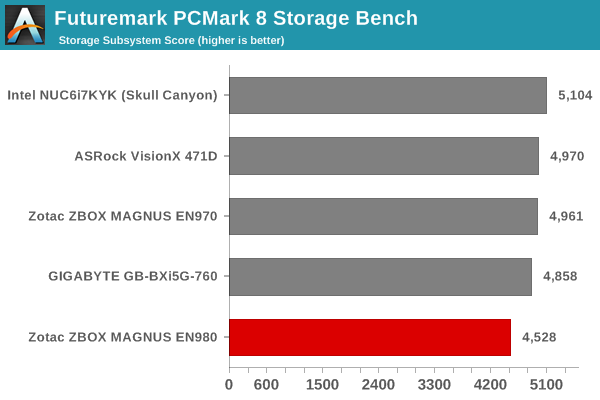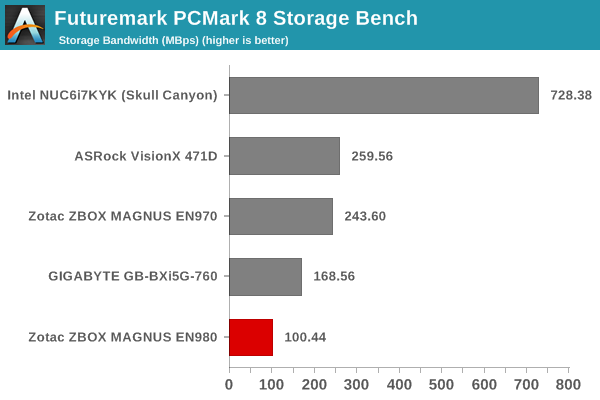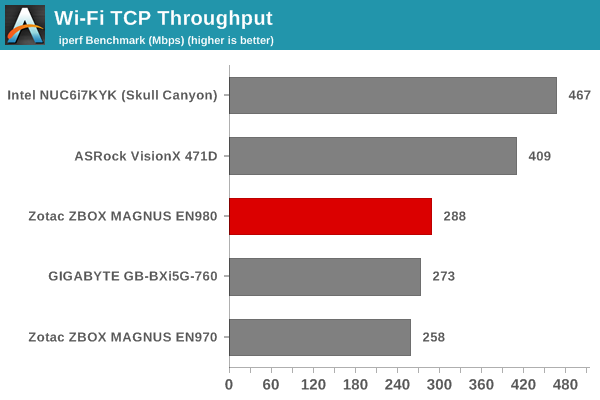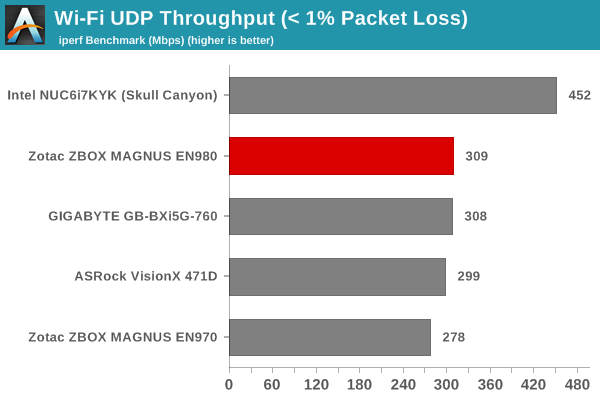Zotac ZBOX MAGNUS EN980 SFF PC Review - An Innovative VR-Ready Gaming Powerhouse
by Ganesh T S on August 25, 2016 8:00 AM ESTNetworking and Storage Performance
Networking and storage are two major aspects which influence our experience with any computing system. This section presents results from our evaluation of these aspects in the Zotac ZBOX MAGNUS EN980. On the storage side, one option would be repetition of our strenuous SSD review tests on the drive(s) in the PC. Fortunately, to avoid that overkill, PCMark 8 has a storage bench where certain common workloads such as loading games and document processing are replayed on the target drive. Results are presented in two forms, one being a benchmark number and the other, a bandwidth figure. We ran the PCMark 8 storage bench on selected PCs and the results are presented below.


The Mushkin Atlas Vital is based on the tried-and-tested SandForce SF-2281 platform. Since it is more of an economical alternative, it doesn't stand out in the benchmarks against other NVMe rivals. That said, the Atlas Vital M.2 2280 SSD is definitely a better alternative compared to a hard disk drive.
On the networking side, we restricted ourselves to the evaluation of the WLAN component. Our standard test router is the Netgear R7000 Nighthawk configured with both 2.4 GHz and 5 GHz networks. The router is placed approximately 20 ft. away, separated by a drywall (as in a typical US building). A wired client is connected to the R7000 and serves as one endpoint for iperf evaluation. The PC under test is made to connect to either the 5 GHz (preferred) or 2.4 GHz SSID and iperf tests are conducted for both TCP and UDP transfers. It is ensured that the PC under test is the only wireless client for the Netgear R7000. We evaluate total throughput for up to 32 simultaneous TCP connections using iperf and present the highest number in the graph below.

In the UDP case, we try to transfer data at the highest rate possible for which we get less than 1% packet loss.

The numbers are very respectable for a 1x1 802.11ac solution.










30 Comments
View All Comments
nathanddrews - Thursday, August 25, 2016 - link
Revision 2.0 with Pascal and PCIe SSD should be interesting. The tiny design is really neat.Chaitanya - Thursday, August 25, 2016 - link
V2 with 1080 or 1070 has already been announced.nathanddrews - Thursday, August 25, 2016 - link
...ImSpartacus - Thursday, August 25, 2016 - link
That's going to be awesome. I hope they can cram some kaby lake in there as well as it'll surely have some minor improvements over Skylake.lament - Thursday, August 25, 2016 - link
Not v2 though.. different model EN10: http://techreport.com/news/30526/zotac-magnus-en10...Morawka - Thursday, August 25, 2016 - link
Tiny? this thing is huge. sure it's smaller than your typical M-ITX case but not far from it.Einy0 - Friday, August 26, 2016 - link
Is it just me or is a 250GB SSD is not enough for a gaming PC. I thought it would be enough a few years ago and quickly discovered that I was constantly shuffling games over to a HDD to make room. Most of the games from the past few years are about 40GB a piece. Looking at my current Steam folder, the Witcher 3 is 38GB and Shadow of Mordor is 42GB. With Windows 10 and a standard load of common apps and utilities, you are looking at 4 to 5 games installed. I suppose if you only use it for games it would okay.jamyryals - Thursday, August 25, 2016 - link
Looks like a terrific little box. The visual comparison to the Nuc was especially helpful to get size context. Too bad they couldn't get the Pascal cards in on this version.fallaha56 - Thursday, August 25, 2016 - link
too bad? deal breaker more like! no point being this far behind the curve...gtx1060 would wipe floor wit at every levelBrokenCrayons - Thursday, August 25, 2016 - link
It's an interesting system. As already mentioned in another comment, the NUC size comparison is useful for putting things in perspective about just how much more physical space it takes to gain gaming performance.I do question this line though:
"At this point of time, a premium gaming PC that can't be advertised as VR-ready can't get good market reception."
The monetary returns for companies producing VR hardware and VR-enabled software for consumer use isn't easy to find and we haven't had enough time or products out there to see any enduring trends about the latest round. All I've got is personal experience to work with here, but I see very little consumer demand because of the cost of entry and the unaddressed shortcomings that we saw with 90's era headgear being duplicated in current hardware.